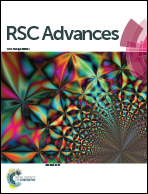Supercapacitive performance of electrochemically doped TiO2 nanotube arrays decorated with Cu2O nanoparticles
Abstract
Highly ordered TiO2 nanotube arrays (TNAs) with enhanced electronic conductivity treated by introducing oxygen vacancies have been considered to be a promising electrode material for supercapacitors. In this work, we fabricated electrochemically doped TiO2 nanotube arrays (ED-TNAs) through a facile cyclic voltammetry method, and then deposited the uniformly dispersed Cu2O nanoparticles onto ED-TNAs to synthesise a high performance electrode for a supercapacitor. The ED-TNAs electrode exhibited a high specific capacitance of 5.42 mF cm−2 at a scan rate of 10 mV s−1, which was about 59 times higher than for the pristine TNAs electrode. Moreover, the ED-TNAs were demonstrated to be an appropriate support for Cu2O nanoparticles. The highest specific capacitance of the Cu2O/ED-TNAs electrode could reach 198.7 F g−1 at the current density of 0.2 A g−1, and approximately 88.7% of the initial capacitance was retained after 5000 cycles of galvanostatic charge–discharge.


 Please wait while we load your content...
Please wait while we load your content...